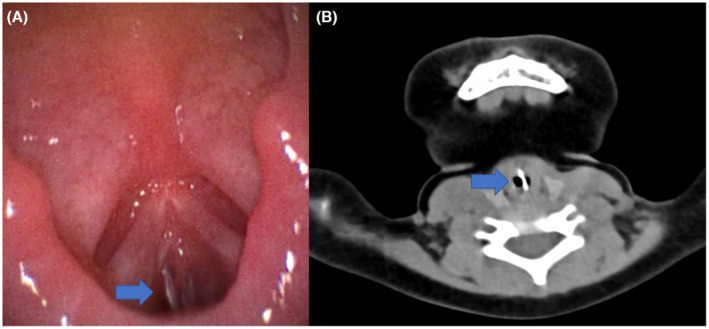Abstract
Key clinical message
The recurrence of respiratory symptoms without a clear clinical reason in children can be secondary to the presence of an unknown foreign body of the airways. In such cases, endoscopy of the airways is always necessary, regardless of the patient's age.
Abstract
The management of foreign bodies of the pediatric airway can be challenging. The clinical presentation may vary and, in case of recurrent respiratory symptoms without a clear clinical cause, the presence of a foreign body of the airway should be suspected. We describe the case of a 13‐month‐old patient, weight 11 kg, with a misdiagnosed subglottic foreign body causing dysphonia and worsening respiratory distress, removed by means of a direct laryngotracheoscopy in tubeless general anesthesia in spontaneous breathing.
Keywords: ear, nose, and throat; emergency medicine; pediatrics and adolescent medicine
1. CASE REPORT
The management of foreign bodies (FB) of the pediatric airway can be challenging. The clinical presentation may vary and, in case of recurrent respiratory symptoms without a clear clinical cause, the presence of a FB of the airway should be suspected. 1 We describe the case of a 13‐month‐old patient, weight 11 kg, with dysphonia and respiratory distress. The patient was admitted to a hospital with the diagnosis of “laryngospasm” and then discharged after medical therapy. She was later admitted to another hospital for the recurrence of respiratory symptoms. In this case, an otolaryngological consultation without laryngoscopy was performed. Due to the worsening of symptoms the patient was transferred to our hospital with the diagnosis of “subglottic laryngitis.” A flexible HD videolaryngoscopy was performed, showing edema of the laryngeal mucosa with an unclear image of subglottic stenosis (Figure 1A). A CT scan of the neck showed a subglottic radiopaque FB (Figure 1B). An urgent videolaryngotracheoscopy in tubeless general anesthesia was performed (Video S1, Figure 2A): the FB (a piece of aluminum) (Figure 2B) was removed by means of microforceps without any complications. After monitoring in the pediatric intensive care unit for 24 h, the patient was dismissed at home a few days later without any respiratory symptom. The recurrence of respiratory symptoms without a clear clinical reason can be secondary to the presence of an unknown FB of the airways. In such cases, endoscopy of the airways is always necessary, regardless of the patient's age. 2
FIGURE 1.

Flexible HD videolaryngoscopy showed edema of the laryngeal mucosa with an unclear image of subglottic stenosis (A, blue arrow); a CT scan of the neck showed a subglottic radiopaque foreign body exactly in the middle of the subglottic space (B, blue arrow).
FIGURE 2.

Urgent videolaryngotracheoscopy in tubeless general anesthesia was performed (A), showing the foreign body (A), removed with microforceps successfully (B); the foreign body was a piece of aluminum deriving from a tablets package (C).
AUTHOR CONTRIBUTIONS
Francesca Fraccaroli: Conceptualization; data curation; investigation; methodology; project administration; resources; software; supervision; validation; visualization; writing – original draft. Davide Tosini: Data curation; investigation; supervision. Giorgia Lerario: Data curation; investigation; supervision. Ludovica Battilocchi: Data curation; funding acquisition; investigation; methodology; project administration; resources; supervision; validation; visualization; writing – review and editing. Alessandra D'Onghia: Investigation; methodology; supervision. Giovanna Cantarella: Investigation; methodology; validation; visualization; writing – review and editing. Lorenzo Pignataro: Project administration; validation; visualization; writing – review and editing. Simona Neri: Investigation; methodology; supervision; validation; visualization; writing – review and editing. Michele Gaffuri: Conceptualization; data curation; methodology; project administration; resources; supervision; validation; visualization; writing – original draft; writing – review and editing.
FUNDING INFORMATION
This research did not receive any specific grant from funding agencies in the public, commercial, or not‐for‐profit sectors. All procedures performed in studies involving human participants were in accordance with the ethical standards of the institutional and national research committee and with the 1964 Helsinki Declaration and its later amendments or comparable ethical standards.
CONFLICT OF INTEREST STATEMENT
The authors have no conflicts of interest to declare.
CONSENT
Written informed consent was obtained from the patient to publish this report in accordance with the journal's patient consent policy.
Supporting information
Video S1
Fraccaroli F, Tosini D, Lerario G, et al. A misdiagnosed laryngeal foreign body causing recurrent wheezing in a pediatric patient: Case report. Clin Case Rep. 2023;11:e7476. doi: 10.1002/ccr3.7476
DATA AVAILABILITY STATEMENT
Data and materials are available on request.
REFERENCES
- 1. Keil O, Schwerk N. Foreign body aspiration in children – being safe and flexible. Curr Opin Anaesthesiol. 2023;36:334‐339. doi: 10.1097/ACO.0000000000001251 [DOI] [PubMed] [Google Scholar]
- 2. Ngamsanga S, Vathanophas V, Ungkanont K, Tanphaichitr A, Wannarong T. Pediatric respiratory tract foreign bodies in children: a systematic review. Auris Nasus Larynx. 2022;S0385‐8146(22):00218‐00218. doi: 10.1016/j.anl.2022.10.003 [DOI] [PubMed] [Google Scholar]
Associated Data
This section collects any data citations, data availability statements, or supplementary materials included in this article.
Supplementary Materials
Video S1
Data Availability Statement
Data and materials are available on request.


